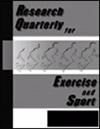对技术较差的青少年进行澳大利亚推荐的基本上手投掷技术标准指导的有效性。
IF 1.6
4区 教育学
Q3 HOSPITALITY, LEISURE, SPORT & TOURISM
引用次数: 2
摘要
目的:本研究旨在探讨运用三维运动分析方法,指导澳大利亚推荐的低技能青少年基本臂外投掷技术标准对运动能力的影响。方法:将技能较差的非运动积极小学生和技能较好的运动积极小学生分别分为FMS组(n = 97)和运动组(n = 129)。分析了人口统计学、人体测量学、全身运动学(离散和时间序列角位移和角速度数据)、运动协调性(节段测序)和运动性能(最大球释放速度)。基线资料比较采用独立t检验和卡方检验;采用重复测量方差分析评估相互作用效应。通过比较95%置信区间内的区域来分析时间序列运动数据的变化。结果:技能较差的学生在运动能力上只有适度的提高。FMS组显著获得13/75离散运动变量(p)。结论:推荐的儿童技能标准不适合早期青少年的发育和年龄。定量3D运动数据的使用提供了比内容验证的技能标准更精确和更适用于发展的基本甩臂标准。应修改建议的技能标准,以方便教师和教练进行有效的教育。本文章由计算机程序翻译,如有差异,请以英文原文为准。
The Effectiveness of Coaching the Australian Recommended Fundamental Overarm Throwing Skill Criteria for Less-Skilled Adolescents.
ABSTRACT Purpose: The aim of this study was to investigate the effects of coaching the Australian recommended fundamental overarm throwing skill criteria for less-skilled adolescents on movement competency using three-dimensional (3D) motion analysis. Methods: Less-skilled non-sports-active and skilled sports-active pupils were assigned to FMS Group (n = 97) and Sports Group (n = 129), respectively. Demographic, anthropometric, whole-body kinematic (discrete and time-series angular displacement and angular velocity data), motor coordination (segmental sequencing) and motor performance (maximum ball release speed) were analyzed. Baseline data were compared using independent T-tests and Chi-Square tests; interaction effects were assessed using repeated-measure ANOVAs. Changes in time-series kinematic data were analyzed by comparing the areas enclosed by the 95% confidence intervals. Results:There was merely a modest improvement in motor competency for the less-skilled pupils. The FMS group significantly acquired 13/75 discrete kinematic variables (p < .01) and four movement patterns but not motor coordination (p = .469) and motor performance (p = .756). Prior to the intervention, the pupils acquired 4/7 recommended skill criteria. The descriptions of another three criteria were not appropriate with no improvement in motor coordination and performance. Two new skills were identified and improved after the FMS intervention. Conclusions: The recommended skill criteria for children were not developmentally and age-appropriate for early adolescents. The use of quantitative 3D motion data provided a more precise and developmentally applicable fundamental overarm throwing criteria than content validated skill criteria. The recommended skill criteria should be modified to facilitate teachers and coaches for effective education.
求助全文
通过发布文献求助,成功后即可免费获取论文全文。
去求助
来源期刊
CiteScore
4.30
自引率
0.00%
发文量
125
审稿时长
6-12 weeks
期刊介绍:
Research Quarterly for Exercise and Sport publishes research in the art and science of human movement that contributes significantly to the knowledge base of the field as new information, reviews, substantiation or contradiction of previous findings, development of theory, or as application of new or improved techniques. The goals of RQES are to provide a scholarly outlet for knowledge that: (a) contributes to the study of human movement, particularly its cross-disciplinary and interdisciplinary nature; (b) impacts theory and practice regarding human movement; (c) stimulates research about human movement; and (d) provides theoretical reviews and tutorials related to the study of human movement. The editorial board, associate editors, and external reviewers assist the editor-in-chief. Qualified reviewers in the appropriate subdisciplines review manuscripts deemed suitable. Authors are usually advised of the decision on their papers within 75–90 days.

 求助内容:
求助内容: 应助结果提醒方式:
应助结果提醒方式:


